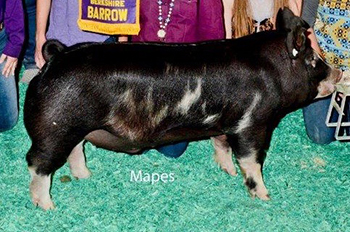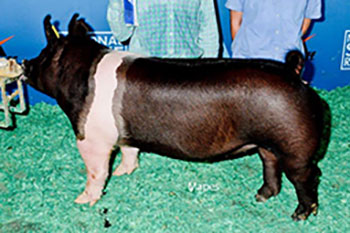|
Judging Contest Classes
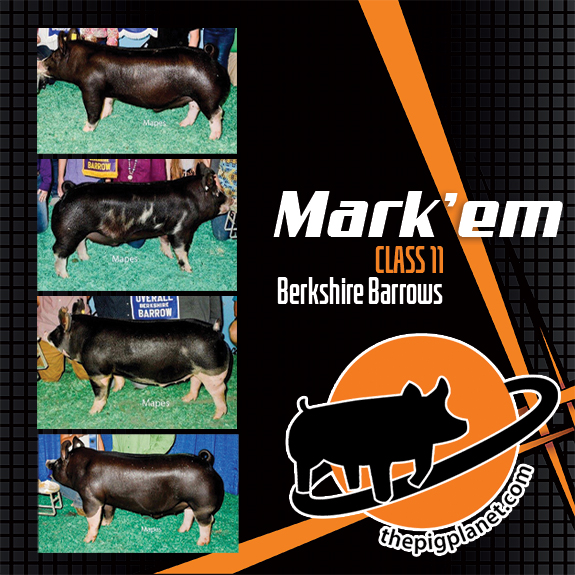
CLASS 11 - Berkshire Barrows
Now closed! Check back soon for official placings & reasons!
CLASS 10 - Hereford Gilts
Placing: 4-2-1-3 Cuts: 3-2-4
II like the Hereford Gilts 4-2-1-3. In my mind, 4 represents an immense amount of quality. She’s the big footed, dense featured one that is still pliable in her center body. To add to that, she too is the most elite and proportional in her look from the side while still blending the right kind of muscle and skeletal comfort to make her an exciting breeding piece. Now, if you’re strictly into the basic brood sow fundamentals of mass, pliability and function, then you’ll undoubtedly be a fan of 2. For me though, she’s the frailer featured one that reads plainer about her head and neck and I question just how genuine her mass is.
Yet in the middle, I find myself reaching back to those brood sow basics and marking it 2-1. 2 reads more maternal in the look she offers from the profile and stays more correct in the set and angle to her blade and knee. Furthermore, that combination leads me to believe that she will have more longevity in the crate. Sure, 1 reads cleaner in her neck line and leaner through her lower body and underline, but I question how the straighter shouldered, tighter flanked, rounder hipped gilt will hold up in a production setting.
In my final decision, I still prefer the elite pieces that 1 has to offer. The bigger footed more extended gilt, puts together a more attractive and shapelier look that will be easier to build around. I realize that 3 is softer in the center part of her body but unfortunately, I struggle to get her to balance appropriately as she needs more feature at the surface and I need to resculpt the way she’s put together up front. Thank you.
CLASS 9 - Yorkshire Gilts
Placing: 1-2-3-4 Cuts: 2-3-5
I like the Yorkshire gilts 1-2-3-4. In an extremely competitive top trio, I side with the 1 gilt to start. This one is extremely hard to pick a hole in. She blends elite angles, bone and feature, and a captivating presence. She is bold and powerful over the top side of her skeleton and simply reads as a productive brood sow in the making. Now, I think 2 is an extremely high-quality female in her own right. She has unbelievable shape and spread to her upper rib cage and is extremely attractive from her blade forward. Ultimately, she is not as extreme in her density of bone and wants to soften on her front pasterns, leaving her second in an extremely tough top pair.
Yet in the middle pair, you cannot deny her elevation, natural spread, and aggressive top shape. She can certainly make her presence known through the production of high-quality stock. Taking nothing away from yet another elite female that falls into third. This is an extremely complete female that stands on immense bone and stays up on her toes. She is bulky and three-dimensional from every angle. Yet, her three-dimensional shape works to her demise as she comes in a more compact package and is shorter in her hip, therefore limiting her range of motion.
On the bottom, I never questioned my decision to mark them 3-4. The shorter bodied gilt’s feature at the ground and balanced and attractive look paired with her muscle shape and dimension make her a logical third. Now, I realize that 4 is a long-bodied gilt and has a productive shape through her rib and upper skeleton. However, she is not only the frailest gilt in the class, but she needs to be leveled up in her hip, stand on a more correct set of running gear, and give a more attractive silhouette from the side. Thank you.
CLASS 8 - Crossbred Gilts
Placing: 1-2-4-3 Cuts: 3-3-2
I like the crossbred breeding gilts 1-2-4-3. In a class that presents some challenges, I still opt to start the blue butt 1 gilt. This is the balanced and attractive gilt of the drive, she is extremely level in her top line and out of her hip, she is pliable in her center body and simply put is the most attractive when viewed from the side. Now I'll admit, I would like to see her stouter at the ground and more correct on her pasterns, yet her practicality and dimension allow her to stay on top. Now, I think that 2 is a high-quality female herself. She stands on a larger circumference of bone and has plenty of power and shape over the top side of her skeleton. I just wish she was taller at the point of her shoulder and read with a more attractive and youthful look.
The remaining trio of belted gilts each have their individual advantages, but I still like them 2-4 in the middle. 2 simply is the longer hipped female that reads right her in angles and therefore should drive with more comfort and ease. I realize that the blue belted gilt is extremely elevated, big in her forearm, bold in her blade, and certainly drives away with great muscularity. But, I think her skeleton is by far the most concerning, she is forward in her blade, straight in her hock and short in her hip.
But on the bottom it is her maturity and frame size that gives her the advantage. She simply is the fresher and shapelier gilt that needs to stay off the bottom. Now the 3 gilt that rounds out the class has a giant hind leg and a powerful hip. She just does not balance up when you step to the side. She is round and plain in the shape on the top side of her skeleton, and the quicker maturing gilt is too jammed up in her front 1/3. Thank you.
class 7
CLASS 7 - Spot Gilts
Placing: 3-1-2-4 Cuts: 4-2-5
I like the Spot gilts 3-1-2-4. In my mind, 3 is the logical place to land. She offers unmatched density of skeleton, a functional look, and the right kind of angles that lend to a comfortable running gear. Furthermore, she’s the most proportional in her body shape and is the most unique in terms of her look from the side. Sure, 1 is another fresh bodied gilt that offers an aggressive shape and turn out of the back side of her blade and outer flare to her stifle. But, she too is plainer in her look up front and shorter and rounder out of her hip.
Yet in my intermediate decision the debate intensifies. In my mind though, build and skeletal quality dictate and 1-2 placing. 1 has the more modern show pig proportions while staying more athletic in her build. I’d agree that 2 is denser at the surface and more elevated on her front pasterns. Unfortunately, I struggle to get her to balance appropriately. She reads shorted and quicker in her kind and more pulled up in her flank.
Yet in my bottom pair, there’s an easier choice to make, 2 beats 4. The more naturally elevated gilt combines a more eye-catching design with a fresh and yet still feminine look. More importantly, she offers more pliability and roll to her rib cage which suggests that she will have more utility in the crate. That’s not to say that 4 doesn’t have some pieces worth taking a chance on. She is arguably the biggest backed gilt of the drive. For me though, I have to have them more maternal in their build. She’s the harshest centered and the most rigid in her skeletal angles, so she stay’s fourth. Thank you.
class 6
CLASS 6 - NJSA Grand Gilt Drive
Placing: 1-2-4-3 Cuts: 3-2-3
I like the NJSA Grand Gilts 1-2-4-3. In my mind, the Duroc gilt represents an immense amount of quality. She’s big footed, dense featured, and pliable in her center body. It’s that elite combination that allows her to check off both the show gilt and brood sow basics. Furthermore, she too is ideal in her proportions, genuine in her running gear, and deadly in her look from the profile, all of which makes her an exciting place to start in my opinion. Now, that’s not meant to take away from the belted gilt. She ties a long and refined head and neck out of her blade while still being three dimensional through the center part of her skeleton and staying square and true at the surface. However, she reads more upright in her front end and rounder in her hip, so I’ll leave her second.
When we get into the middle pair of gilts that merit a more thought-provoking discussion, the Hampshire gilt offers a more unique package, particularly for her breed. She’s cleaner and tighter about her jawline, more ideal in the set to her pasterns up front, sexy looking from the side and most importantly reads with a comfortable and flexible hock and rear leg. Now I’ll admit that the Yorkshire gilt is broader in her skull, bigger legged, and longer hipped. For me though, she reads plainer about her head and neck, more advanced in her composition, and most importantly I have to pick her up on her front feet.
Regardless, she still brings more positives to the forefront in the bottom pair. I prefer her added balance and skeletal correctness from the side. She reads squarer out of her hip and is more correct about the set to her hind leg. Without a doubt, the Landrace gilt has some intriguing pieces for her breed. She is ideal in her frame size and yet still reads with an immense amount of density and power, but I think her skeleton presents the most challenges. She is straighter in her blade and rear hock and I need to re-sculpt the way she is put together from the side. Thank you.
class 5
CLASS 5 - Duroc Barrows
Placing: 1-4-3-2 Cuts: 5-3-5
I like the Duroc Barrows 1-4-3-2. To me, 1’s combination of elite proportions and the right kind of muscle make him the easy place to land. He’s a fresh bodied barrow that is big bladed and has more outer turn to his hip and stifle. Furthermore, he lays that added shape and power on a functional and athletic skeleton. Now, the darker pigmented barrow is an elevated, dense made hog that opens with an aggressive turn and spread to his upper skeleton. It’s just unfortunate that while creating this blend of muscularity and stoutness, we’ve sacrificed some of his agility and skeletal build. He will pitch forward in his blade and gets a bit shorter and rounder in his hip.
When we get into the middle pair of barrows that deserve a bit more discussion, I still can’t get past the added density of skeleton and presence from the profile that 4 brings to the table. He’s more elevated and extended from his blade forward while being stouter in his skull, jawline, and forearm. Now, 3, in his own right, is longer and leveler out of his hip and reads with more reach and comfort to his rear leg. However, I’ve got to pick him up on his front feet and paint a more elite picture from the side.
Regardless, he still dominates the bottom pair. I prefer his added balance and skeletal correctness. At the same time, his pliable heavy weight design provides him with the basic market hog look. I realize the barrow that closes has a broader shape to his skull, a defined and ultra-lean look, and great shape up high. But past that, he’s the shortest in his neck, the harshest in his center body, and the straightest in his hock. Thank you.
class 4
CLASS 4 - Cross Barrows
Placing: 4-1-2-3 Cuts: 3-2-5
I like the Cross Barrows 4-1-2-3. With quality of all different kinds, I'll side with the one that best covers balance and proportionality with added extras in terms of power and presence. The wide belted barrow offers an impressive density of skeleton while still maintaining an elevated and fresh look from the profile. He too is bold in the center part of his body and has more outer turn to his hip and stifle. I'll admit that 1 is another attractive barrow from the side that ties in neat about his head and neck. I do like the added bend and comfort to his blade and knee as well, but comparatively he lacks the bulk and shape to run with 4.
When we get into the middle pair of barrows that both represent quality of different kinds, it’s tough to get them divided, but for me personally I side with the presence and skeletal quality of 1. He’s neater at the base of his jawline, more extended from his blade forward, and is more correct in the set to his hip and hind leg. Now, if mass and shape are your thing, then without a doubt it’s easy to side with 2. The traditional belted barrow is bolder in his body shape and more aggressive in the turn and spread to his upper skeleton. However, I need him to offer more extension from the side and I’d like the lengthen his hip and make him more comfortable skeletally.
Regardless, he still dominates the bottom pair. His fresh square look starts at the top of his blade and transitions into a dynamically-shaped upper rib cage. Sure 3 is deep and pliable in his center body, but I struggle to get him to fit together as well. He reads rounder and plainer in his shape and more advance in his composition. Thank you.
Class 3
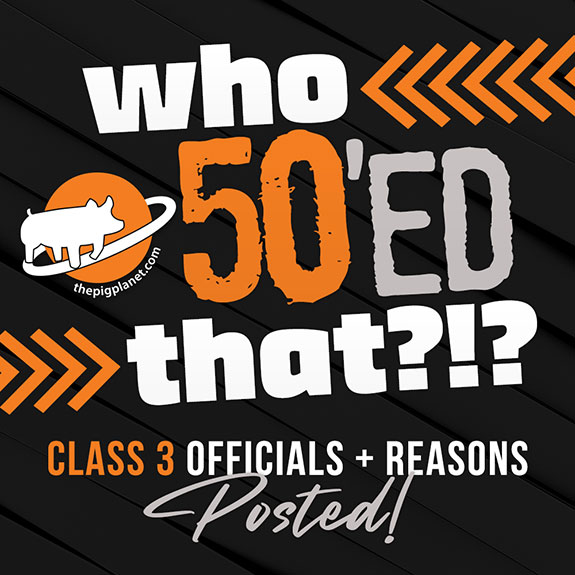
Class 3 - Gilts
Placing: 1-3-2-4 Cuts: 3-2-3
I like the Cross gilts 1-3-2-4. In my mind, the 1 gilt does the most ideal job of combining a show gilt look with the basics of build, body, and skeletal quality. She maintains the best proportionality of a fresh and feminine look, a pliable body shape, and yet most importantly lays it on a comfortable and athletic running gear. Now, if mass and bulk are where you lay your emphasis, you’ll no doubt love 3. She’s the stoutest in her skull and feature and the most robust in the center portion of her skeleton. However, in my mind, she reads plainer about her face and neck and I question how genuine her mass is.
Yet, in my intermediate decision, I’m more intrigued by the brood sow basics that 3 has to offer. Ultra-stout in her forearm and maternal in her look from the side, while still being longer in her hip and more relaxed in the angle to her blade. I’d agree that 2 is cleaner in her throat and reads fresher at the top side of her neck, but I question if the traditional belted gilt has the comfort and flexibility to last in production.
In the final decision, build and angles dictate a 2-4 placing. To be brief, 2 offers more slope to her shoulder and reads with more length and function to her rear skeleton. I realize 4 is denser at the ground and reads broader through her head, but I struggle to get her to balance appropriately. She is straighter and more upright in her blade and more rigid in her hock, so I'll leave her fourth. Thank you.
CLASS 2
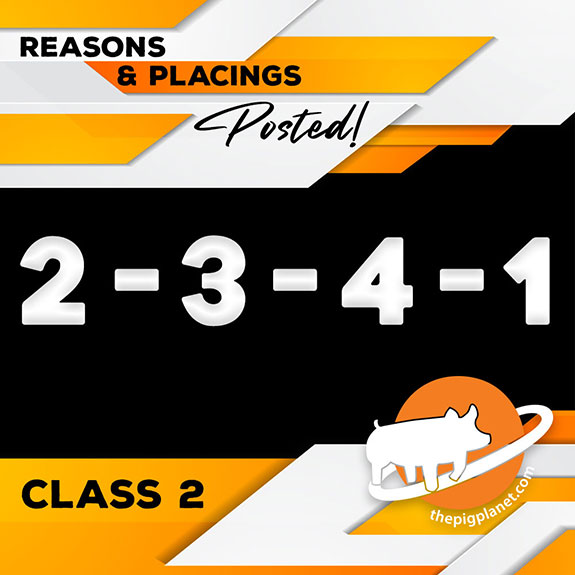
Class 2 - Poland Barrows
Placing: 2-3-4-1 Cuts: 3-2-5
I like the Poland barrows 2-3-4-1. In short, 2 best covers the basics of a productive market hog, while bringing forth the extras. To start, he offers a powerful view from the profile while still maintaining elevation and extension. Furthermore, the pliable centered barrow counters his impressive muscularity with a great density of feature. Now I'll admit that 3 is stronger off of his front pasterns and more correct in the set to his hip and rear leg, but realistically he needs to be rounder in his body shape and cleaned up in his head and neck.
The middle pair becomes moderately more challenging, but it’s my commitment to build and balance that keeps 3 over 4. Not only is 3 stronger in his topline, but he too is genuine in his muscle shape and still reads athletic and comfortable in his angles. I’d agree that 4 is more prominent in his jaw line, but aside from this single trait advantage, I struggle to move him up anymore in class. He is frailer in his feature, easy in his spine, and plainer in the shape to his upper skeleton.
In the final decision, the logical mark is 4-1. 4 clinches the pair advantage in muscle composition, freshness, and skeletal quality. Sure 1 has a denser forearm and a giant rear leg, but that alone doesn’t counter his faults. He’s the straight bladed, short hipped, light muscled one that stays fourth. Thank you.
CLASS 1
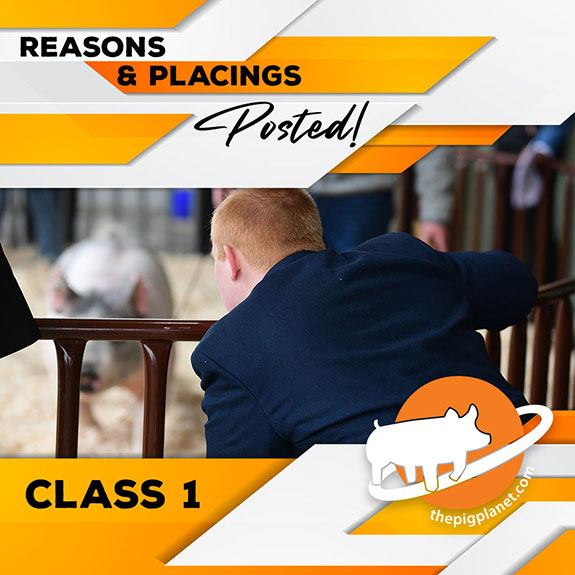
Class 1 - Landrace Gilts
Placing: 1-3-4-2 Cuts: 5-2-2
I like the Landrace gilts 1-3-4-2. 1’s unmatched quality, build, and look make her the logical place to start. She offers the most density of skeleton and pairs that with an attractive, high quality look from the side. Furthermore, she’s the most ideal in her body shape and reads the most comfortable in her angles. Without doubt, she has the most dominating ring presence and will be the most influential as a sow. Past the class winner, the challenge intensifies, but I still opted for 3. Her pliable center body along with the spread and upper dimension out of the back side of her shoulder are impressive, but I need to intensify her bone, strengthen her front pasterns, and loosen her rear skeleton.
The remaining trio each offer intriguing positives, but I’m still most comfortable sorting them 3-4 in the middle. 3 is bold and dimensional through the center portion of her skeleton, while still maintaining elevation and presence from the side. I’d agree that 4 sets down on a bigger foot and stouter forearm while being more ideal in her body composition, but in my mind, she flattens in her forerib and doesn’t blend as well from the profile.
In the final decision, basic fundamentals keep 4 ahead of 2. She’s trimmer and neater about her head and neck, more correct in her hip and hind leg, and has the advantage in terms of stoutness. 2 still brings some compelling positives to the forefront, bold in her ribcage and sow-like in her build. For me though, she’s straighter and more rigid in her hock, plainer in her look up front, and frailer in her feature at the ground. Thank you.

Disclaimer: Thepigplanet.com strives to bring you accurate, timely show results, sale highlights and event information. In order for this service to be available, we rely on a number of people and offices to assist with compiling information. While we intend to only publish the facts, in some rare cases there may be some inaccuracies. If this does occur, please notify us and we will correct the error upon proper notification. |



